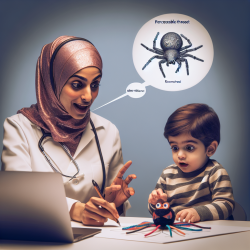Introduction
Understanding the development of threat-biased attention in children is crucial for speech-language pathologists (SLPs) who aim to create effective therapeutic interventions. A recent study titled Converging neural and behavioral evidence for a rapid, generalized response to threat-related facial expressions in 3-year-old children provides valuable insights into how young children process emotional expressions. This research highlights the importance of recognizing threat-related facial expressions and the implications for socioemotional development. As practitioners, we can leverage these findings to enhance our therapeutic approaches, particularly in online therapy settings like those offered by TinyEYE.
Key Findings
The study employed event-related potential (ERP) and eye-tracking measures to assess children's responses to facial expressions. The research demonstrated two critical outcomes:
- By age three, children exhibit a generalized neural and behavioral response to threat-related emotions, specifically fear and anger, without differentiating between these expressions.
- Machine learning models using early-stage neural responses to threat can predict attentional dwell time on threat-related faces, indicating a unified neural system for processing these emotions.
These findings suggest that by age three, children have developed a rapid, unified response to threat-related facial expressions, which could be pivotal in understanding their socioemotional development.
Implications for Practice
For SLPs, especially those working with young children, these findings can inform the development of targeted interventions. Here are a few practical applications:
- Assessment and Screening: Incorporate assessments that evaluate children's responses to threat-related facial expressions. Understanding these responses can help identify children at risk for socioemotional challenges.
- Therapeutic Interventions: Develop interventions that focus on improving emotional recognition and regulation skills. By helping children better understand and manage their responses to threat-related expressions, we can support their overall emotional development.
- Parental Involvement: Educate parents about the importance of emotional recognition and how they can support their child's development at home. Encourage activities that promote emotional awareness and expression.
Encouraging Further Research
While this study provides a solid foundation, there is still much to learn about the neural and behavioral mechanisms underlying threat-biased attention in young children. SLPs are encouraged to engage in further research to explore these areas:
- Investigate the long-term socioemotional outcomes associated with early threat-biased attention.
- Examine the impact of therapeutic interventions on modifying threat-biased attention patterns.
- Explore the role of environmental factors, such as parental interactions and educational settings, in shaping children's threat responses.
Conclusion
The study of threat-biased attention in young children is a promising area of research that can significantly impact speech-language pathology practice. By integrating these findings into our therapeutic approaches, we can better support the emotional and social development of the children we serve. To delve deeper into the original research, please follow this link: Converging neural and behavioral evidence for a rapid, generalized response to threat-related facial expressions in 3-year-old children.










